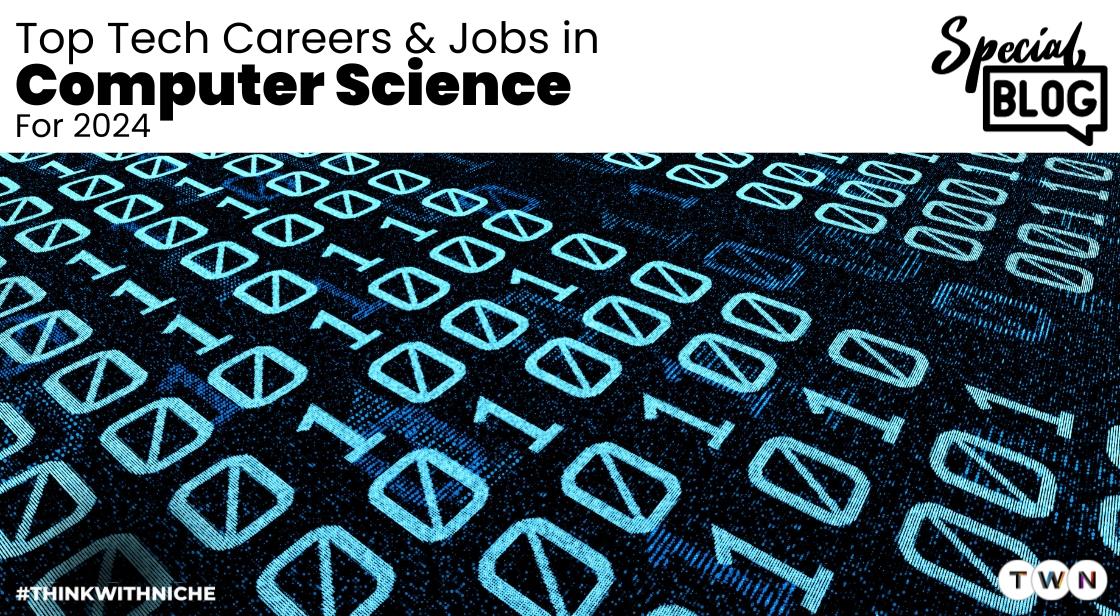Top Tech Careers and Jobs in Computer Science for 2024

Blog Post
Welcome to the forefront of technological evolution! In the landscape of the digital era, computing power reigns supreme, revolutionizing every facet of our lives.
This omnipresence, fueled by relentless innovation and propelled by groundbreaking fields like Robotics, Artificial Intelligence (AI), and Robotic Process Automation (RPA), heralds an era of unprecedented career opportunities in computer science for 2024 and beyond.
The digital heartbeat of our world, characterized by the convergence of smart devices, intelligent systems, and colossal data processing infrastructure, lays the foundation for a dynamic spectrum of career pathways.
As we surge into 2024, the tech industry becomes a veritable goldmine for aspiring professionals seeking a career embedded in innovation, creativity, and transformative impact.
From architects sculpting the future of intelligence to demystifiers decoding the language of data and the architects building the digital infrastructure, the tech realm forges a myriad of career avenues.
Embracing roles that span the spectrum from AI Engineers, Robotics Designers, and Data Scientists to Cloud Engineers, Security Architects, and UX/UI Designers, this tech-centric universe beckons the visionary, the problem-solver, and the pioneer.
Join us as we delve into the top tech careers and jobs in computer science, exploring the intricacies, demands, and fascinating trends that define these roles in 2024.
Discover how these fields are reshaping industries, carving new pathways, and propelling us into a future where technological prowess intersects seamlessly with human ingenuity.
Buckle up as we navigate the dynamic and burgeoning landscape of tech careers, empowering you with insights, skillsets, and an expansive vision of the tech world that awaits in 2024.
Gear up for the future! Explore the hottest tech careers and jobs in computer science for 2024, powered by the explosive growth of computing power and driven by cutting-edge fields like Robotics, AI, and RPA.
Computing power is no longer a mere convenience; it's the lifeblood of the digital age. From smart devices in our pockets to complex infrastructure behind the scenes, everything hums with the power of data processing. And this relentless march of technological advancement is creating a goldmine of exciting career opportunities in computer science for 2024 and beyond.
Top Tech Careers and Jobs in Computer Science for 2024:
A. The Architects of Intelligence:
The frontiers of computer science are ablaze with the power of artificial intelligence. This domain holds the key to revolutionizing countless industries, from healthcare and finance to manufacturing and transportation.
Within this landscape, three critical roles stand out as the architects of intelligence, shaping the future with their expertise:
1. AI Engineer
Core Responsibilities of AI Engineer:
-
Design and develop AI algorithms and models.
-
Train and optimize AI systems on large datasets.
-
Integrate AI models into software applications and platforms.
-
Monitor and evaluate the performance of AI systems.
-
Ensure ethical and responsible implementation of AI.
Key Skills of AI Engineer:
-
Strong understanding of machine learning and deep learning concepts.
-
Proficiency in programming languages like Python, R, and Java.
-
Familiarity with cloud computing platforms like AWS and Azure.
-
Excellent analytical and problem-solving skills.
-
Strong communication and teamwork skills.
Average Base Salar of AI Engineer (US): $115,000 (Glassdoor, 2023)
Latest Trends of AI Engineer :
-
Generative AI is rapidly evolving, creating realistic images, text, and even music.
-
Explainable AI (XAI) is gaining traction, enabling humans to understand how AI models make decisions.
-
Reinforcement learning is advancing, allowing AI agents to learn through trial and error in complex environments.
Example: An AI engineer working for a healthcare company might develop an AI model that analyzes medical scans to detect cancer with greater accuracy.
2. Robotics Engineer
Core Responsibilities of Robotics Engineer :
-
Design and build robots for various applications.
-
Develop control systems and software for robot movement and behavior.
-
Integrate sensors and actuators into robots.
-
Test and evaluate robot performance.
-
Ensure safety and security of robot operations.
Key Skills of Robotics Engineer:
-
Strong understanding of mechanics, electronics, and control systems.
-
Proficiency in programming languages like C++ and Python.
-
Familiarity with robotics simulation software.
-
Mechanical design and prototyping skills.
-
Strong analytical and problem-solving skills.
Average Base Salary of Robotics Engineer (US): $106,000 (Glassdoor, 2023)
Latest Trends of Robotics Engineer:
-
Collaborative robots (cobots) are becoming increasingly popular in manufacturing settings.
-
Soft robotics is emerging, creating robots with more flexible and human-like movements.
-
AI is being integrated into robots, enabling them to make autonomous decisions and adapt to changing environments.
Example: A robotics engineer working for a logistics company might develop a robot that can autonomously navigate a warehouse and pick and pack orders.
3. AI Architect
Core Responsibilities of AI Architect:
-
Design and plan the architecture of complex AI systems.
-
Choose the appropriate AI algorithms and tools for specific tasks.
-
Ensure scalability, reliability, and efficiency of AI systems.
-
Manage the development and deployment of AI projects.
-
Oversee ethical considerations and compliance with regulations.
Key Skills of AI Architect:
-
Deep understanding of AI technologies and architectures.
-
Strong systems design and architectural planning skills.
-
Experience with software development methodologies and project management.
-
Excellent communication and collaboration skills.
-
Ability to translate business requirements into technical solutions.
Average Base Salary of AI Architect (US): $142,000 (Glassdoor, 2023)
Latest Trends of AI Architect:
-
Federated learning is gaining traction, allowing AI models to be trained on decentralized data sources.
-
Edge computing is enabling AI processing at the edge of the network, closer to the data source.
-
The need for responsible AI governance and frameworks is increasing.
Example: An AI architect working for a financial institution might design and implement a fraud detection system powered by AI, ensuring the security of financial transactions.
Also Read: How AI Transformed Healthcare in 2023: Redefining Diagnosis and Treatment
B. Data Demystifiers:
In the age of big data, where information flows like rushing rivers, the ability to extract insights and build knowledge is the lifeblood of every industry. Three key roles stand as data demistifiers, navigating the information tsunami and transforming raw numbers into actionable intelligence:
1. Data Scientist:
Core Responsibilities of Data Scientist :
-
Design and implement data analysis pipelines.
-
Clean and prepare large datasets for analysis.
-
Develop and apply statistical models and machine learning algorithms.
-
Analyze data to identify patterns, trends, and correlations.
-
Communicate findings through reports, visualizations, and presentations.
-
Collaborate with other stakeholders to translate insights into action.
Key Skills Data of Scientist:
-
Strong understanding of statistics, probability, and machine learning concepts.
-
Proficiency in programming languages like Python, R, and SQL.
-
Familiarity with data analysis tools and platforms like Jupyter Notebook and Tableau.
-
Excellent analytical and problem-solving skills.
-
Strong communication and data storytelling skills.
Average Base Salary Data Scientist (US): $122,000 (Glassdoor, 2023)
Latest Trends:
-
Increased focus on explainable AI (XAI) to make data models more interpretable and trustworthy.
-
Rise of natural language processing (NLP) for analyzing unstructured text data.
-
Growing adoption of edge computing for real-time data analysis near data sources.
Example: A data scientist working for a retail company might analyze customer purchase data to identify buying patterns and predict future demand, optimizing inventory and marketing strategies.
2. Machine Learning Engineer:
Core Responsibilities of Machine Learning Engineer:
-
Design and build machine learning models and algorithms.
-
Train and optimize machine learning models on large datasets.
-
Integrate machine learning models into software applications and platforms.
-
Monitor and evaluate the performance of machine learning models.
-
Deploy and maintain machine learning systems in production environments.
Key Skills of Machine Learning Engineer:
-
Strong understanding of machine learning algorithms and techniques.
-
Proficiency in programming languages like Python and Java.
-
Familiarity with cloud computing platforms like AWS and Azure.
-
Excellent software development and systems engineering skills.
-
Strong analytical and problem-solving skills.
Average Base Salary of Machine Learning Engineer (US): $136,000 (Glassdoor, 2023)
Latest Trends:
-
Increased adoption of deep learning and reinforcement learning for complex tasks.
-
Rise of MLOps practices for automating the machine learning development lifecycle.
-
Focus on responsible AI and mitigating bias in machine learning models.
Example: A machine learning engineer working for a financial institution might develop a model to detect fraudulent transactions in real-time, protecting customers and minimizing financial losses.
3. Data Analyst:
Core Responsibilities of Data Analyst:
-
Collect data from various sources.
-
Clean and prepare data for analysis.
-
Perform basic data analysis using statistical techniques and visualization tools.
-
Identify trends and patterns in data.
-
Create reports and dashboards to communicate data insights.
-
Support decision-making with data-driven recommendations.
Key Skills of Data Analyst:
-
Strong understanding of data analysis concepts and techniques.
-
Proficiency in SQL and data visualization tools like Excel and Tableau.
-
Communication and analytical skills to interpret data and tell compelling stories.
-
Attention to detail and ability to work with large datasets.
Average Base Salary of Data Analyst (US): $82,000 (Glassdoor, 2023)
Latest Trends of Data Analyst:
-
Increased demand for data analysts with specialized skills in areas like business intelligence and marketing analytics.
-
Rise of self-service analytics platforms empowering business users to explore data independently.
-
Focus on storytelling and data visualization to effectively communicate insights to stakeholders.
Example: A data analyst working for a healthcare provider might analyze patient data to identify risk factors for certain diseases, enabling more targeted preventive care measures.
C. Builders of the Digital Infrastructure:
In the digital age, where everything from communication to commerce thrives online, the foundation lays in the hands of the builders of the digital infrastructure.
These skilled professionals shape the invisible backbone of the internet, ensuring seamless functioning, security, and innovation. Here are three vital roles shaping the future of our online experience:
1. Cloud Engineer:
Core Responsibilities of Cloud Engineer:
-
Design and architect secure and scalable cloud infrastructure on platforms like AWS, Azure, or GCP.
-
Manage and optimize cloud resources for cost-efficiency and performance.
-
Automate infrastructure provisioning and deployment using tools like Terraform and Ansible.
-
Implement continuous integration and continuous delivery (CI/CD) pipelines for rapid software deployments.
-
Monitor and troubleshoot cloud infrastructure issues to ensure uptime and reliability.
Key Skills of Cloud Engineer:
-
Deep understanding of cloud computing concepts and services.
-
Proficiency in scripting languages like Python or Bash.
-
Familiarity with infrastructure as code (IaC) tools and cloud security best practices.
-
Excellent problem-solving and analytical skills.
-
Strong communication and collaboration skills.
Average Base Salary of Cloud Engineer (US): $118,000 (Glassdoor, 2023)
Latest Trends of Cloud Engineer:
-
Increased adoption of multi-cloud environments for greater flexibility and resilience.
-
Rise of serverless computing for easier application scaling and agility.
-
Focus on sustainability and green cloud initiatives to reduce environmental impact.
Example: A cloud engineer working for a streaming service might design and manage the cloud infrastructure that powers video delivery to millions of users globally, ensuring smooth playback and scalability during peak demand.
2. Security Architect:
Core Responsibilities of Security Architect:
-
Design and implement comprehensive security architectures for networks, systems, and applications.
-
Identify and mitigate cybersecurity vulnerabilities and threats.
-
Manage firewalls, intrusion detection systems, and other security tools.
-
Conduct security audits and penetration testing to assess potential risks.
-
Develop and implement incident response plans and disaster recovery procedures.
-
Stay up-to-date on the latest cybersecurity threats and trends.
Key Skills of Security Architect:
-
Strong understanding of cybersecurity concepts and frameworks (MITRE ATT&CK, NIST Cybersecurity Framework).
-
Proficiency in security tools and technologies like SIEM, IDS/IPS, and vulnerability scanners.
-
Familiarity with network security protocols and encryption technologies.
-
Excellent analytical and problem-solving skills.
-
Strong communication and collaboration skills to educate stakeholders on security risks.
Average Base Salary of Security Architect (US): $134,000 (Glassdoor, 2023)
Latest Trends of Security Architect:
-
Growing adoption of zero-trust security models for least-privilege access and reduced attack surface.
-
Rise of artificial intelligence (AI) and machine learning (ML) for automated threat detection and incident response.
-
Focus on cloud security and securing containerized applications and Kubernetes environments.
Example: A security architect working for a financial institution might design and implement a multi-layered security architecture to protect sensitive financial data from cyberattacks, ensuring customer trust and regulatory compliance.
3. DevOps Engineer:
Core Responsibilities of DevOps Engineer:
-
Bridge the gap between development and operations teams, promoting collaboration and communication.
-
Automate software development and deployment processes using DevOps tools like Git, Jenkins, and Docker.
-
Configure and manage continuous integration and continuous delivery (CI/CD) pipelines.
-
Implement infrastructure as code (IaC) for consistent and repeatable infrastructure provisioning.
-
Monitor and troubleshoot application performance and infrastructure issues.
-
Stay up-to-date on the latest DevOps tools and methodologies.
Key Skills of DevOps Engineer:
-
Strong understanding of software development lifecycles (SDLC) and DevOps principles.
-
Proficiency in scripting languages like Python or Bash.
-
Familiarity with CI/CD tools, containerization technologies, and configuration management tools.
-
Excellent communication and collaboration skills to bridge the gap between development and operations.
-
Ability to work in a fast-paced environment and learn new technologies quickly.
Average Base Salary of DevOps Engineer (US): $104,000 (Glassdoor, 2023)
Latest Trends of DevOps Engineer:
-
Increased adoption of GitOps for version control and automated infrastructure management.
-
Rise of platform engineering teams to build and maintain reusable infrastructure and DevOps tools.
-
Focus on observability and monitoring to ensure application and infrastructure health in complex deployments.
Example: A DevOps engineer working for a software company might automate the entire software delivery process, from code push to production deployment, reducing manual tasks and ensuring faster and more reliable software releases.
Also Read: Top Fashion Brands: The Best Clothing Brands in the World
D. Beyond Code: Emerging Tech Stars:
The tech landscape is not just about lines of code; it's about human-centric solutions powered by cutting-edge technologies. Here, three rising stars stand out, pushing the boundaries of what's possible and shaping the future we interact with technology:
1. RPA Specialist:
Core Responsibilities of RPA Specialist:
-
Identify and analyze repetitive tasks suitable for automation.
-
Design and implement RPA workflows using tools like UiPath or Blue Prism.
-
Integrate RPA solutions with existing software systems.
-
Monitor and maintain RPA bots for optimal performance.
-
Train and support users on how to interact with RPA solutions.
Key Skills of RPA Specialist:
-
Understanding of business processes and workflow optimization.
-
Proficiency in RPA tools and scripting languages like Python or VBA.
-
Analytical and problem-solving skills to identify automation opportunities.
-
Strong communication and collaboration skills to work with stakeholders.
-
Attention to detail and ability to test and troubleshoot RPA workflows.
Average Base Salary of RPA Specialist (US): $88,000 (Glassdoor, 2023)
Latest Trends of RPA Specialist:
-
Shift towards cognitive RPA with AI integration for increased automation capabilities.
-
Rise of RPA as a service (RaaS) for flexible and scalable automation solutions.
-
Focus on responsible RPA implementation and impact on workforce dynamics.
Example: An RPA specialist working for a customer service department might automate repetitive processes like data entry and order processing, freeing up customer service representatives to focus on more complex inquiries and personalized interactions.
2. Blockchain Developer:
Core Responsibilities of Blockchain Developer:
-
Design and develop secure and scalable blockchain applications.
-
Implement smart contracts using languages like Solidity.
-
Integrate blockchain solutions with existing infrastructure.
-
Secure and manage blockchain networks.
-
Stay up-to-date on the latest blockchain technologies and trends.
Key Skills of Blockchain Developer:
-
Strong understanding of blockchain architecture and consensus mechanisms.
-
Proficiency in smart contract development languages like Solidity.
-
Knowledge of cryptographic concepts and security best practices.
-
Excellent problem-solving and analytical skills.
-
Strong communication and collaboration skills to work with diverse stakeholders.
Average Base Salary of Blockchain Developer (US): $146,000 (Glassdoor, 2023)
Latest Trends of Blockchain Developer:
-
Increased adoption of blockchain for supply chain management, identity verification, and decentralized finance (DeFi).
-
Rise of hybrid blockchain solutions combining public and private chains for greater flexibility.
-
Focus on scalability and sustainability of blockchain technologies.
Example: A blockchain developer working for a logistics company might build a blockchain-based platform for tracking goods throughout the supply chain, ensuring transparency, efficiency, and traceability.
3. UX/UI Designer:
Core Responsibilities of UX/UI Designer:
-
Design user interfaces and user experiences for websites, mobile apps, and software applications.
-
Conduct user research and usability testing to understand user needs and pain points.
-
Create wireframes, prototypes, and mockups to visualize design concepts.
-
Collaborate with developers and other stakeholders to ensure seamless implementation of designs.
-
Stay up-to-date on the latest design trends and user-centered design principles.
Key Skills of UX/UI Designer:
-
Strong understanding of user interface (UI) and user experience (UX) design principles.
-
Proficiency in design tools like Figma, Sketch, and Adobe XD.
-
Visual design skills and aesthetic sense to create user-friendly and visually appealing interfaces.
-
Empathy and understanding of human-computer interaction.
-
Communication and collaboration skills to work effectively with diverse teams.
Average Base Salary of UX/UI Designer (US): $93,000 (Glassdoor, 2023)
Latest Trends of UX/UI Designer:
-
Increased focus on accessibility and inclusive design for diverse users.
-
Rise of microinteractions and storytelling to create engaging user experiences.
-
Adoption of artificial intelligence (AI) and machine learning (ML) in design tools for personalization and optimization.
Example: A UX/UI designer working for a healthcare app might design intuitive and user-friendly interfaces for patients to manage appointments, access medical records, and communicate with healthcare providers, simplifying the healthcare experience.
Conclusion:
This is just a glimpse into the diverse and dynamic landscape of tech careers in 2024. The opportunities are limitless for those with the right skills and passion for innovation.
Embrace lifelong learning, hone your expertise in specialized fields, and prepare to join the ranks of the pioneers shaping the future with the power of technology!
The future of work is digital, and computer science is its driving force. By embracing the skills and opportunities highlighted in this article, you can position yourself for a thriving career in the exhilarating world of tech.
So, what are you waiting for? Start your journey into the future of computer science today!
You May Like
EDITOR’S CHOICE












